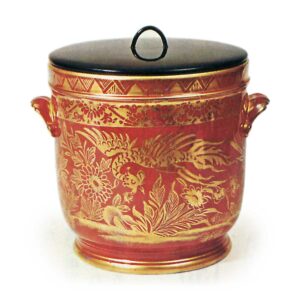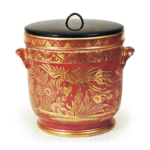
The French chemist Léaumur obtained kaolin and other raw materials for Chinese porcelain from the Jesuit d’Entrecol, who had written a report on his observations of porcelain, mainly from Jingdezhen, China. He studied this and gradually got closer to the secrets of porcelain by using powdered glass as a material. around 1758, Blanca, a chemist who was a member of the Academy, succeeded in making the raw clay for porcelain from Alanson clay. This process was patented in England in 1766. Earlier, in 1738, a factory for porcelain was established in Vincennes with two men who had worked in the Chantilly pottery factory as engineers. Porcelain production was also studied in Chantilly, using Japanese Arita porcelain as a model, and a factory was established in 1725. Experiments in Vincennes were a success in 1740, and in 1753 the factory was moved to Sèvres, where it became a royal factory under the protection of the king and the famous Madame de Pompadour. During this period, much effort was devoted to the study of porcelain base materials, and in 1745, scientific research began, led by Jean Elo, a chemist and member of the Academy, followed by the Makel research. Thus, in 1768, the original clay for hard porcelain was finally perfected. This was made from kaolin produced near Limoges. It took 30 years, but this was enough to break the dominance of German Meissen porcelain. Despite the fact that both Meissen and Sèvres kept their research strictly secret from each other, Begger and Makel independently discovered kaolin and arrived at the porcelain base. This is an example that clearly proves that the European ceramic industry was based on a scientific foundation. In 1753, yellow, dark blue, and blue-green were produced, followed by light green in 1756, and the famous rose pink (also known as Pompadour Rose) in 1757. The division of labor was divided between engraving, mold making, pouring, repairing, painting, and gold-burning, and it is recorded that there were 17 men and 17 women in the painting department. The Sèvres continued to wax and wane, but it remained active in response to new artistic changes. In the nineteenth century, many pieces in the Chinese style were produced, including celadon porcelain and family roses. The sculptor Rodin also left works. The production of porcelain panels for decorating furniture had already begun in the mid-18th century, and like Wedgwood, the production of artificial jewelry was also early. The Sèvres was not only a center of fine art, but also of technological innovation. The museum attached to the museum is known for its many outstanding collections. (Savage, G., Porcelain, 1962; Weiss, G., Ullstein Porzellbuch, 1966)








